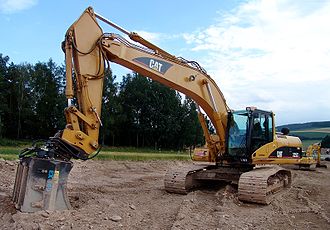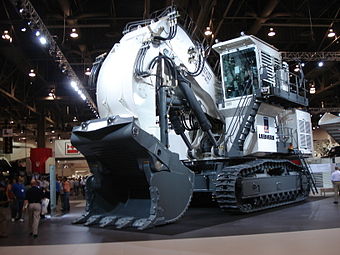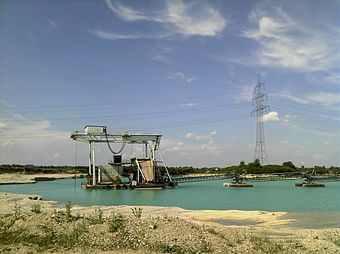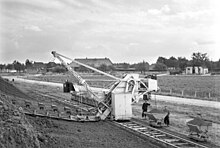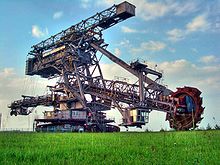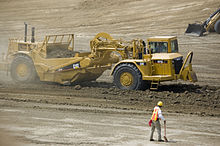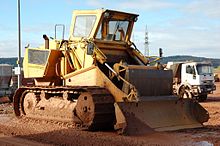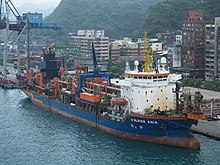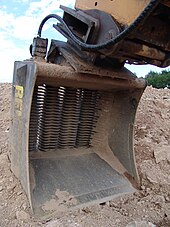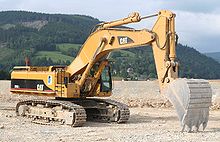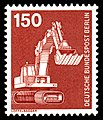Excavator
An excavator is a construction machine for loosening and moving soil and rock, in particular for digging and backfilling of earth depressions such as construction pits and shafts. Excavators are also used to move bulk and other goods and to extract coal and ores in open-cast mining .
Excavators are, with a few exceptions, such as floating dredgers, self-propelled land vehicles and are used on uneven or unpaved terrain. Therefore, they are usually designed for high off-road mobility, which is usually achieved with an all-wheel drive or caterpillar tracks . The mechanical movement of the boom and the bucket or a bucket wheel is usually effected by hydraulics or with electric motors. The excavator is usually driven by one or more diesel , more rarely also gas or electric motors, which if necessary also generate the oil pressure for the excavator hydraulics via hydraulic pumps.
Previously common practice, cable mechanisms for shovel or bucket movement are now mostly only used in large and very large excavators.
etymology
The term excavator comes from Dutch (cf. Baggeren) and originally denotes a sand or mud scraper (a worker engaged in the activity of clearing the harbor floor ).
Outline of excavators
Due to the diverse designs and areas of application of excavators, they can be divided according to different criteria. A higher-level distinction is possible based on the active principle used to loosen soil or rock. In
- mechanical
- hydraulic and
- pneumatic
Differentiated dissolving methods. Combinations such as mechanical-hydraulic loosening are also used. In the specialist literature, excavators, which detach soil and rock purely mechanically by means of a digging vessel , are divided into single-vessel excavators , multi- vessel excavators and flat excavators , depending on the type of excavation . The arrangement and shape of the grave vessel largely determines the operating conditions and the performance of an excavator in certain soil conditions. The rock and soil cutters also loosen the soil and especially rock purely mechanically, but in contrast to the bucket excavators with several chisels.
The excavators that loosen the soil purely hydraulically include the suction excavators , whereby a combination of mechanical and hydraulic loosening is used with these machines. Excavators that use a pneumatic release method are called pneumatic excavators . Compared to the mechanically and hydraulically releasing excavators, pneumatic excavators are rarely found.
Single-vessel dredger
Single-vessel excavators are characterized by the fact that they are equipped with a single digging vessel for digging and loading. Since there is an interplay between digging and loading, the single-vessel excavators are referred to as discontinuous or discontinuous excavation processes. The difference to the flat excavator is that the feed for removing the soil is not generated by moving the entire excavator, but the digging vessel of the machine is moved. One also speaks of a standing excavator. The single-vessel excavators are further broken down into single-purpose and multi- purpose machines based on their intended use . Single-purpose machines are designed for a very specific extraction task, sometimes even for a specific location. They are mainly used in open-cast mining or in large-scale construction projects such as sewer construction. Multipurpose machines , also known as universal excavators, can be operated with different work equipment, which makes them particularly suitable for universal use in construction. Universal excavators are used in smaller mining operations such as quarries or gravel pits . Compared to the single-purpose machines, transport is possible with reasonable effort.
A further breakdown is based on the historical development of single-vessel excavators for both single and multi-purpose machines based on the principle of power transmission used in rope excavators and hydraulic excavators . In the case of rope excavators, the drive energy is transmitted to the digging tool by means of winches and steel cables. Hydraulic excavators, on the other hand, have a hydraulic unit . The digging tools are moved via hydraulic cylinders .
The design of a single-vessel excavator depends largely on the digging tools that are selected based on the nature of the soil. Due to the different modes of operation of the cable shovel and hydraulic excavator, not all digging tools can be used for both machine types. In addition to the actual digging tools, other attachments were developed for the universal excavators that are not used to loosen and move excavated material. The following table provides an overview of the most important digging and loading tools for single-vessel excavators and their possible uses. Since there are significant differences between the design of land-based and floating single-vessel dredgers, these are described separately. Floating dredgers are often referred to as dredgers and land-based dredgers as dry dredgers. Strictly speaking, however, dredgers include all those dredgers that convey dredged material that is below the surface of the water. An example of this is a dragline crane with a scraper that picks up gravel from the bank.
| land-based single-vessel dredgers | ||
|---|---|---|
| Dragline excavator | ||
| Single-purpose machines | ||
| Shovel | Shovel dragline excavators as single-purpose machines are used in large open-cast mines, such as B. the coal and ore extraction, used. They dissolve the soil directly or pick up previously blasted material and load it into dump trucks or via mobile crushers onto conveyor systems. | |
| Scraper | In opencast mining, large dragline excavators with scrapers are used to move overburden. They have a walking mechanism to move about and the long boom allows them to transport overburden over a comparatively large distance. | |
| Multipurpose machines | ||
| Shovel | Shovel dragline excavators as multi-purpose machines were used on larger earthworks and are now largely replaced by hydraulic excavators. Smaller quarries have also used these universal excavators with shovel equipment, as there were no special single-purpose machines for excavators with small to medium-sized buckets. | |
| Backhoe bucket | Before the spread of the hydraulic excavator, universal excavators with backhoes were used on construction sites to dig pits and were standard machines on construction sites until the 1960s. | |
|
Grab ( clamshell grab ) |
For material handling in factories and ports as well as on construction sites for loading and unloading dump trucks, a cable excavator with grab equipment was the standard machine in the twentieth century. Despite being displaced by hydraulic excavators, rope excavators with grabs are still occasionally used, as the boom gives them a greater working radius than hydraulic excavators. | |
| Scraper | Multipurpose dragline excavators with scraper equipment are mainly used in sand and gravel pits. At Kiesseen , these machines are used in particular to move the dredged material out of the water while the dredger is on land. | |
| Diaphragm wall grab | For digging trenches for diaphragm walls, universal excavators with special diaphragm wall equipment are used. Due to the depth of excavation, this is difficult with hydraulic machines. | |
| Hydraulic excavator | ||
| Single-purpose machines | ||
| Shovel | For the extraction of raw materials, hydraulic excavators with shovels are used in small and medium-sized open-cast mining operations instead of rope excavators. These are more economical and require less maintenance than duty cycle crawler excavators. In larger opencast mines, for example the coal mine in the USA, rope excavators are still used in a discontinuous mining process. | |
| Multipurpose machines | ||
| Backhoe bucket | Hydraulic excavators with backhoe buckets are used on every earthwork site worldwide. They are used to dig excavations and move soil and have completely replaced dragline excavators with backhoes. | |
|
Grab ( clamshell grab ) |
In the construction industry, hydraulic excavators with grabs are used as attachments for digging trenches and for loading soil. The change to other work equipment such as the backhoe is possible within a shorter time thanks to the quick coupler. Compared to the grippers that are used in rope excavators and that are closed by cable pulls, these grabs are operated by hydraulic cylinders. | |
Other attachments that are used with Universal excavators, for example, ramming equipment , wrecking balls , rock chisel and drilling and completion equipment. See also attachments .
| floating single-vessel dredgers | ||
|---|---|---|
| Dragline single-purpose machines | ||
| Shovel | Floating excavators with shovel are used when high tear-out forces are required to loosen rock below the surface of the water. This is the case, for example, when excavating docks or canals in rocky areas. Shovel dredgers are mainly used in North America and England. There they are called dipper dredgers . They are not found on the European mainland. | |
|
Grab ( clamshell grab ) |
Floating dredgers with grab equipment are used in hydraulic engineering and for handling bulk goods. While small and medium-sized dredgers consist of a conventional dragline crane superstructure that is mounted on a pontoon, larger machines are special constructions, some of which also have additional stilts for stabilization and their own drive. Dredgers with grab equipment are suitable for lighter soils. The maximum possible excavation depth is 35 m. | |
| Floating grab systems, also known as depth grabbers, are used in gravel and sand works for extraction. With an excavation depth of up to 100 meters, they can extract raw materials wherever it is no longer possible to use bucket chain and suction excavators. | ||
| Single-purpose hydraulic excavators | ||
| Backhoe bucket | Hydraulic excavators for dredging mainly consist of conventional superstructures that are mounted on a ship or pontoon. They are used for hydraulic engineering and for the maintenance of inland waters and ports. Due to the limited boom length, the radius of action is limited to shallow water depths. | |
| Gripper | ||
Multi-vessel excavators
Multi-vessel excavators have several digging vessels that are endlessly connected to each other and are driven in a rotating manner. As a result, there is constant digging and unloading, which is why multi-vessel excavators are also referred to as continuously or continuously operating excavators. With multi-vessel excavators, the feed takes place either by adjusting the excavator tool or by moving the entire machine. Based on the type of power transmission to the digging vessels, the multi-vessel excavators are divided into bucket-chain excavators and bucket-wheel excavators . With both machine types, the dredged material is picked up with the digging vessels and returned to another location. As a rule, they are delivered to a conveyor belt .
Bucket ladder excavator
Bucket-shaped digging vessels are attached to an endless chain, the bucket chain. The chain is driven by a drive turas by means of a motor and gearbox and deflected at one or more points. The dredged material is released from the rotating buckets and transported in them to the delivery point.
Bucket chain excavators can be divided into land-based and floating based on their location. A further breakdown is often based on the size and application. Floating bucket chain excavators can also be divided into river excavators and sea excavators. While river dredgers are used in inland waters for gravel and sand extraction as well as for deepening and maintenance of waterways and do not have their own propulsion system, sea dredgers are ocean-going ships often with their own propulsion system. While river dredgers were in use in many places in the first half of the 20th century, sea dredgers are less common as bucket chain dredgers. They are used for land reclamation as well as in marine mining.
| land-based bucket ladder excavators | ||
|---|---|---|
| Trench excavator with a chain of buckets | In the construction industry, trenches for cables and lines are dug with, among other things, bucket chain trenchers, with trenchers or trenchers with a bucket wheel being used today. | |
| small bucket ladder excavators | Use in smaller companies in the basic industry, particularly for the extraction of loam and clay in brickworks. | |
| Medium size bucket ladder excavator | Use in larger mining operations in the basic industry, especially in gravel and sand extraction. Up to the middle of the 20th century, medium-sized bucket chain excavators were also used on larger earthworks, e.g. B. used in sewer construction. | |
| Bucket chain excavator as a large-scale opencast mining device | Use in larger opencast mines for lignite and chalk extraction. | |
| floating bucket ladder excavators | ||
| River dredger | Bucket chain excavators are used on pontoons to extract gravel and sand in inland waters. With these, the mining material is conveyed from depths of up to approx. 20 meters and loaded onto floating conveyor systems or barges. The dismantling position of the excavator is changed using steel cables attached to the bank and appropriate winches on the pontoon. They do not have their own drive. | |
| For the maintenance of ports and shipping routes as well as for gravel extraction in larger rivers, bucket chain excavators are used in addition to suction dredgers. These are usually much larger than the bucket chain excavators that work in gravel and sand pits. Tugs are mainly used to change the excavator position. These bucket chain excavators are also designed as a pontoon and do not have their own drive. The hoisting machine used to be powered by a steam engine. Today these have diesel engines. Related article: Dredger Minden |
||
| Special bucket chain excavators, the so-called gold excavators, are used for gold and tin mining in North America and Australia. Some of these contain complete processing systems. Related Articles: Gold Excavators | ||
| Sea excavator | Seaworthy bucket chain excavators with their own drive are known as sea excavators. Compared to the pontoon-supported river dredgers, they are assigned to the ships . Because of their special use in hydraulic engineering near the coast and in marine mining, sea dredgers are quite rare. | |
Bucket wheel excavator
In the bucket wheel excavators, the digging vessels are firmly attached to a wheel that is driven by a gear. Classification of bucket wheel excavators: with feed, without feed.
| Trench excavator with bucket wheel | Bucket wheel excavators can also be used as trench excavators. Compared to trenchers and trenchers with a bucket chain, their digging depth is not only limited by the boom, but also by the radius of the bucket wheel. | |
|---|---|---|
| Compact bucket wheel excavators | Compact bucket wheel excavators are used in smaller opencast mines for mining or stockpile operation. They are also used in earthworks when very large amounts of earth have to be mined and moved over a long period of time. Examples of this are the construction of motorways, dams or canals. The devices are standardized today and only have caterpillar tracks. The conveyed goods are usually transported on with belt systems . | |
| Bucket wheel excavator as a large open pit mining device | Bucket wheel excavators play an important role as mining machines in large open-cast mining operations , especially in open-cast lignite mining in Europe . These large-scale open-pit mining devices are often several hundred meters long and are part of a large system made up of conveyor systems and settlers for continuous conveyance. Related article: Bucket wheel excavator . |
Flat excavator
Flat excavators differ from vessel excavators in the type of soil excavation in the form of thin layers. These are released and moved by the excavator tool or picked up by means of a bucket. The digging movement takes place by moving the entire excavator machine. Flat excavators are mainly used for horizontal earthworks such as leveling surfaces or terrain, whereas single and multi-vessel excavators are mainly used for vertical earthworks. Flat excavators are divided into:
| Graders | Grading machines loosen the soil while driving with a dozer blade as a digging tool, which is arranged on the front of the machine. After loosening, the soil cannot be picked up by the dozer blade, but is pushed by it in front of the machine. Grading machines usually have a crawler track, which is why they can also be used in difficult soil conditions. The main area of application is earthworks. | |
|---|---|---|
| Grader | Graders , also known as levelers, planers or road planes, also loosen the soil with a dozer blade. However, this is located in the middle of the machine, which means that it experiences much less vertical movement when the machine is traveling over uneven ground. In addition, the dozer blade can be rotated. So compared to grading machines, earth planers are used to create terrain and route profiles in earthworks, especially in road construction. | |
| Scraper machines |
|
Scraper machines loosen the soil while driving with a scraper as a digging tool. This is usually arranged in the middle of the machine and picks up the loosened soil after cutting. The filled scraper is then released from the ground and used to transport the soil. At the delivery point, the soil is distributed by tilting the bucket while driving. Scraper machines are divided into scrapers and scrapers . |
Rock and soil milling
|
Open-cast mining (continuous surface miner) |
Open-cast mining machines are continuously working open-cast mining devices that loosen the rock in layers using a milling drum and, in some cases, also convey it to a conveyor system or a dump truck. Opencast mining cutters are used in particular to loosen hard rock, as this is not possible with other opencast mining equipment such as bucket chain excavators and bucket wheel excavators. | |
|---|---|---|
| Asphalt milling | Asphalt milling machines are road construction machines that are used to remove asphalt surfaces. These machines also have milling drums. Strictly speaking, the asphalt milling machines do not belong to the excavation machines, as they do not loosen naturally grown soil, but otherwise they have the characteristics of an excavator, the "loosening and conveying". | |
| Trenching | Trenchers have specially arranged chisels which allow very narrow, deep trenches to be dug. These machines are therefore suitable for automatically laying cables over large distances. |
Suction dredger
Suction dredgers use hydraulic methods to loosen the dredging material. The main field of application of these dredgers is dredging, ie the extraction or removal of sand , gravel or silt from the bottom of a body of water or the seabed (down to a specified depth). A suction dredger essentially consists of a centrifugal pump and a suction line reaching to the bottom. When dredging, water is sucked in directly above the ground, the dredged material being loosened around the suction head by the negative pressure and conveyed into the suction line. On board the suction dredger, the mixture of water and dredged material is either transported directly to the destination by pumps through a floating pipeline or separated from each other again, with the water being returned to the body of water. Since soils that are difficult to loosen can only be sucked in with high pressure, mechanical loosening methods are also used in some suction excavator types. In the case of cutter suction dredgers, for example, the dredged material is loosened by rotating chisels on the suction head and then sucked in.
| purely hydraulic suction excavators | ||
|---|---|---|
| Basic suction dredger in sand pits | Basic suction dredgers are used to convey sand and gravel in the wet process. These consist of a pontoon on which the drive, dredge pump and suction pipe are mounted. The suction pipe is lowered to the bottom of the gravel lake using a lifting device. The dredged material is pumped to the bank via a suction line, which is also attached to pontoons. Suction dredgers for sand and gravel extraction in inland waters can be used up to a depth of approx. 35 meters, with an additional underwater pump up to 50 meters. Since basic suction dredgers do not have any mechanical release aids, they can only be used for easily removable gravel or sand deposits. By using a hydraulic release aid in the form of spray nozzles on the suction head, the so-called jet device, basic suction dredgers can still be used on certain soils that are difficult to remove. | |
| hydraulic-mechanical suction excavators | ||
| Cutter suction dredger ( Cutter excavator ) |
Cutting head excavators have an additional cutting head on the suction head. The rotating chisels arranged there loosen the dredged material before it is sucked in. That is why cutter suction dredgers are particularly suitable for soils that are difficult to remove. Cutter suction dredgers of the same design as basic suction dredgers are used to extract sand and gravel. The machines only have an additional drive for the cutting head. However, larger machines are also in operation for the construction and maintenance of ports and shipping lanes. | |
| Hopper excavator | Hopper dredgers are sea-going suction dredgers that have towing heads arranged on the side. The tow heads have a suction device and mechanical release aids, such as fangs or pressurized water nozzles. The tow heads are pulled over the seabed and the material loosened in this way is transported into the ship via a suction head and pipeline. Hopper excavators are mostly suction excavators, i.e. H. the material is first stored on board and later pumped off board by flushing. Compared to suction dredgers, hopper dredgers are more suitable for light soils such as sand. | |


Constructive features of excavators
Traveling or walking gear
The following trolleys or walking gear are used for land-based excavators:
- Crawler excavators ( tracked vehicles ) with an operating weight of up to 1000 t that travel on caterpillars . In the opencast mine, backhoe excavators up to 6500 t were moved on four double crawler tracks.
- Wheel excavators, also known as mobile excavators, with an operating weight of around 8 t to 100 t, which always travel on wheels. Most wheeled excavators have four-wheel drive .
- All- terrain walking excavators can step over the excavator arm and the pair of wheels (gait-like hobbling), approx. 10 t. In the open pit, the largest dragline excavators walk on two to four “shoes”, up to now 13,500 t. While working they sit on a round base plate.
- Rail-road excavator
Boom types
- Articulated arm
- Telescopic arm
- Reaching articulated arm
- Swivel and tilt joint between the end of the arm and the shovel
- Cantilever with hanging rope (pulley)
- Additional horizontal cable pull of a digger
Classification by size
- Mini excavators or small excavators with an operating weight of around 0.75 t to 6 t that regularly drive on rubber tracks. The smallest excavators are less than 1 m wide and can therefore also be used for special tasks inside buildings (e.g. with hydraulic hammers for smaller demolition work).
- Midi excavators with an operating weight of around 7 t to 10 t, which i. A. ride on wheels.
- Mid-range excavators with an operating weight of around 10 t to 60 t. Motor power 50 kW to 300 kW. 0.5 m³ to 3.0 m³ bucket volume. The larger excavators in this class run on chains. Typical use on construction sites e.g. B. for excavation (light earthworks) or the larger devices for heavy earthworks (road construction, sewer construction).
- Large excavators with an operating weight of around 60 t to 200 t. Motor power 300 kW to 800 kW. 3.0 m³ to 15.0 m³ bucket volume. Use z. B. in quarries.
- Largest excavator with an operating weight of over 200 t to> 10,000 t. Motor power> 800 kW. Conveyor vessel 15.0 m³ to> 100 m³ volume. Use z. B. Ore Extraction.
General descriptions
A standing excavator is usually characterized by a structure that can be rotated through 360 ° with a boom, at the end of which an attachment can be mounted. There are two-part booms called two-piece booms and monoblock booms. The booms and the attachments are moved by hydraulics . Hence it is also called a hydraulic excavator. In addition, there are also rope excavators, bucket wheel excavators , diggers, backhoes, suction excavators and much more
As a special variant, road- rail excavators are also able to drive on the tracks of railways . There are also walking excavators with two wheels and two supports specially designed for rough terrain.
In contrast to the wheel loader , a backhoe excavator is able to work well below its own standing level due to its far liftable and lowerable boom, and is therefore preferred for excavating construction pits and the like. Ä. used. The backhoe loader is a combination of the two .
Excavators almost always only have one driver's seat. When moving in public traffic, only the L driving license is required, as their design-specific maximum speed is generally not higher than 20 km / h.
Attachments
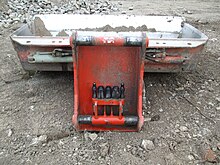
- Attachments for excavators are
-
spoon
- Shovel
- Backhoe bucket
- Ditch cleaning bucket
- Tilting bucket 1
- Removal spoon
- Drainage spoon
- Gripper Bucket / Gripping Tools 1
- → scrap
- Orange peel grab 1
- Magnet 1
- Scrap shears 1
- Pipe wrench 1
- → abort
- Breaker spoon
- Combination or all-purpose spoon
- hook
- spade
- Wrecking ball
- Hydraulic or demolition hammer 1 , demolition chisel
- Xcentric Ripper (alternative to hydraulic hammer)
- Demolition tongs or concrete shears 1
- Fang
- Jaw crusher bucket 1
- Gripping tooth or excavator thumb
- Drill harness
- Milling machine
- Tiltrotators
- Vibration plate 1
- Rotary sieve spoon
- Pulverizer
- → clearing
- Clearing knife
- Root bur 1
- Root cutter 1
- Pruning shears 1
- Rake 1
1 hydraulically operated
A quick-change device is usually installed between the above-mentioned attachments and the excavator stick (clearly visible in the photo of the crawler excavator, painted red). This means that the excavator driver can change the attachments in the shortest possible time without having to leave his cab.
Special-purpose excavators
For special applications such as B. the construction of dykes or generally the creation of embankment profiles, excavators with particularly long or telescopic booms are used, which allow better and more precise surface processing through an increased range.
An excavator with long demolition equipment is a special type of machine that is usually used for demolition. It can demolish buildings with a height of up to 60 m, a novelty in this area is a telescopic demolition excavator from a Dutch demolition company with a reach height of 62 m.
The excavator is to be distinguished from excavators with embankment equipment , which have been developed for other tasks.
An excavator with long demolition equipment has a long boom as standard, which, depending on the application, consists of up to three parts. Two long boom parts are connected with a short middle section and can therefore be flexibly and universally controlled. In general, normal backhoe equipment, technical term: earthworking equipment, is also available, which can be exchanged with the demolition boom.
Manufacturer

Excavator manufacturers (sorted alphabetically)
- Atlas between 2001 and 2010: Terex -Atlas
- Bobcat
- Boki
- Bucyrus International
- BURDE Engineering GmbH
- Case CE
- Caterpillar
- CSM
- Doosan Infracore (formerly Daewoo)
- Etec (A)
- Eurocomach
- Euromach
- Foton Lovol International Heavy Industry Co. Ltd. , China
- Gallmac
- Gehl Company
- Guangxi LiuGong Machinery Co., Ltd, China
- Hanix
- Harness sweep
- Haulotte
- HBM-Nobas , formerly VEB Schwermaschinenbau NOBAS Nordhausen
- Hefei
- Hidromek
- Hitachi Construction Machinery
- Hunan Sunward Intelligent Machinery Co. Ltd. , China
- Hydrema Baumaschinen GmbH
- Hyundai Heavy Industries
- JCB
- John Deere (in USA, Russia)
- Kaiser Fahrzeugwerk AG
- KATO
- Kiefer GmbH
- Kobelco
- Komatsu
- Kubota
- Liebherr
- Macmoter
- Mallaga
- Mecalac
- Menzi Muck
- New Holland Construction
- Pawling & Harnischfeger P&H cable excavator
- Querzola GmbH
- Sany Heavy Industry , China
- Shandong Lingong Construction Machinery Co. Ltd./SDLG, China
- Shantui Construction Machinery Co., Ltd., China
- Sennebogen Maschinenfabrik GmbH
- Takeuchi , Japan
- Terex GmbH
- Topcatt
- Volvo Construction Equipment
- Wacker Neuson
- XCMG , China
- Yanmar , Japan
- Yuchai Engineering Machinery Company Ltd. , China
Defunct manufacturers
- Akerman (S),
- ARA (FIN)
- Bavaria
- Benati (I), today CNH
- Benmac (D / I)
- Benoto (F)
- Benfra (I)
- Brunieri (I)
- Brøyt (NO)
- Bünger (D)
- Cosmoter (I)
- Demag ( taken over by Terex )
- Eder
- Errtmer
- Fuchs, today Terex / Fuchs
- Furukawa (F)
- God Forrest
- Large
- Guria (ES)
- Hatra
- Halla (KO), today Hyundai
- Hanomag
- Hymac (GB)
- International Harvester (USA)
- Klönne (D)
- Kockum Landsverk (S)
- Laltesi (I)
- Lanz
- Marion Power Shovel , today
- at Bucyrus International
- Menck & Hambrock
- Ogela
- O&K Orenstein & Koppel,
- today New Holland Construction
- PelJob,
- Schaeff ,
- today Yanmar
- Simit (I), today CNH
- Tractem (F)
- VEB Weimar plant
- Weser Hut
- Cradle
- Wilhag
- Witten excavator works
- Yumbo (F)
Records
The largest excavators are bucket wheel excavators . The “ 288 ” model, built by Krupp Industrietechnik in 1978 , is currently working in the Garzweiler opencast mine (RWE Power) and has been the largest excavator in the world since it was commissioned. It has an operating weight of 12,840 t, a height of 96 m and a length of 215 m.
The next size range are dragline excavators with electric cable drive and walking gear . The Big Muskie worked in the United States in the 1970s and 1980s. It had an operating weight of 13,500 t and a shovel capacity of 166 m³.
The largest shovel excavator was the cable-driven Marion 6360 with chain drive, called Capitain , from Marion Power Shovel in the USA. The service weight was 12,700 t and the shovel held about 138 m³. It was scrapped in 1992. The next smaller shovel excavator called Big Brutus can still be viewed.
The largest hydraulic shovel excavator in the world has been the Caterpillar 6120B H FS since 2013 with a service weight of 1270 t and a bucket capacity of up to 65 m³. Until a few years ago this record was held by the Bucyrus RH 400 (formerly Orenstein & Koppel ) with an operating weight of 980 t and a bucket capacity of 52 m³. It is produced in Germany, in the Bucyrus factory in Dortmund-Dorstfeld .
The largest hydraulic backhoe excavator in the world is the Liebherr R9800 presented in 2012 with a service weight of 800–810 t and a bucket capacity of up to 47.5 m³.
The largest demolition excavator with a long equipment in Germany is in use at Plannerer Abbruch GmbH from Pullenreuth, which bears the designation BHD-3010 and was developed and built by the company BURDE Engineering GmbH, near Mainz. The machine will be presented to the public in February 2015. The BHD-3010 is equipped with earthworks equipment, 30 m long heavy-duty equipment for tools with an operating weight of 10 t and a telescopic boom. The machine has a total weight of over 150 tons.
The largest demolition excavator with long equipment in Europe was the Cat 5110B, which reached a height of up to 90 m and was built by the now defunct Dutch company Rusch. The whereabouts of the machine is unknown.
Kobelco builds the world's largest demolition excavator. The SK 3500D is a machine from Kobelco with an operating weight of up to 327 t. The SK 3500D can work at a height of 65 m with a 2.9 t demolition shear.
noise
As a guide to the construction site noise of a typical excavator, a WHO report found 90 dB at a distance of 10 m, i.e. H. about 32 sons .
safety
- In Germany, an annual UVV inspection (according to the guidelines of the employers' liability insurance association) is required for excavators.
Model making, toys
There are fully functional, radio-controlled models of excavators that can do minor earthworks. Like the large excavators, they have hydraulics.
Simple mechanical tin toy rope excavators for the room worked with a pull cord via 2 small cranks, pivoting and moving - everything directly by hand. With metal or wooden construction kits, excavators that work freely or according to a template can be built with a lot of effort.
Playground equipment
In slot machine arcades there are devices with glass on 2 to 4 sides, in which - with an electric motor via operating levers or buttons - with a double rope gripper that can be moved on the ceiling or an articulated arm gripper, playing objects such as colored balls can be moved in order to score points achieve. With another type, if the game time is tight, there is the chance to dug one of many transparent balls into a dispensing opening in order to receive the contents of the ball as a reward.
With purely mechanical constructions for sitting on, swiveling with the legs resting on the ground and actuating the arm and shovel using levers for right and left hands, a backhoe, indoors plastic balls or outdoors to dig sand. Free game of skill on playgrounds or in the foyer of shopping centers or furniture stores.
Medial importance
150 Pfennig postage stamp of the definitive series Industry and Technology of the German Federal Post Office (June 12, 1979)
190 Pfennig postage stamp of the Definitive Industry and Technology series of the Deutsche Bundespost (July 15, 1982)
On the TV show Wetten, dass ..? there were bets made with excavators; z. For example, climb a tower, light a lighter, play tennis or use a brush to write the letters of the station “ZDF” on the roof of a car.
See also
- List of construction machinery and construction equipment
- List of construction machinery manufacturers
- Spoon (attachment)
literature
- Günter Kunze, Helmut Göhring, Klaus Jacob: Construction machinery. Vieweg, Braunschweig / Wiesbaden 2002, ISBN 3-528-06628-8 .
- Günter Kühn: Handbook of construction operations - organization, operation, machines. VDI Verlag, Düsseldorf 1999, ISBN 3-18-400933-5 (systematic presentation of excavators and construction machinery in general).
- Ulf Böge, Stefan Heintzsch: Bagger - The great chronicle of all German manufacturers . Podszun, Brilon 2002, ISBN 3-86133-282-5 .
- Ulf Böge, Rainer Volkwein: Weserhütte excavator . Podszun, Brilon 2004, ISBN 3-86133-350-3 .
- Ulf Böge, Stefan Heintzsch, Arnold Düßmann: Atlas Weyhausen - the triumphant advance of hydraulics . Atlas, Hamburg 2007, OCLC 255945662 .
- Ulf Böge, Rainer Volkwein: Liebherr - The Success Story of Hydraulic Excavators Volume 1, Podszun, Brilon 2019, ISBN 3-861339404 .
Media reports
- Olaf Schmidt: excavators - giants of the construction site , WDR 2012
Web links
- History of excavators on the website of the AG Kran- und Baumaschinenmuseum eV
- Excavator story
- The shield for every Menck excavator
- Bar excavator after 1400 ( memento from January 1, 2013 in the web archive archive.today )
- Priestman dry excavator ( memento from January 1, 2013 in the web archive archive.today )
- mechanima.upb.de
- “Dance with an excavator”, film report
- Information on the technology and locations of long-front excavators
- The cleanest excavators of all time ( Memento from April 7, 2014 in the Internet Archive ), Baupraxis Zeitung, 3/2014
Individual evidence
- ^ Petri Foreign Dictionary, 13th edition. 1888.
- ↑ Wolfgang Dachroth: Handbook of building geology and geotechnics. 3. Edition. Springer-Verlag, 2002.
- ↑ Kunze / Göhring / Jacob: Construction machines - earthworks and opencast mining machines. Braunschweig / Wiesbaden 2002, p. 152.
- ↑ Kurth / Pajer / Pfeifer: Large opencast mining equipment and universal excavators. VEB Verlag Technik, Berlin 1971, p. 12.
- ↑ Martin Scheffler: Introduction to conveyor technology: conveyor, function and Commitment. Technik-Tables-Verlag Fikentscher, Darmstadt 1973, p. 230.
- ↑ Kunze / Göhring / Jacob: Construction machines - earthworks and opencast mining machines. Braunschweig / Wiesbaden 2002, p. 152.
- ^ Günter Kühn: Handbook of construction operations - organization, operation, machines. VDI-Verlag, Düsseldorf 1991, p. 218 ff.
- ↑ Wolfgang Dachroth: Handbook of building geology and geotechnics. 3. Edition. Springer-Verlag, 2002.
- ^ Kunze / Göhring / Jacob: Construction machinery earthmoving and opencast mining machines. Braunschweig / Wiesbaden 2002, p. 151, 153 ff.
- ↑ DIN 24080 .
- ^ Kunze, Göhring, Jacob: Construction machines - earthworks and opencast mining machines. Braunschweig / Wiesbaden 2002, p. 151.
- ↑ DIN 24080.
- ↑ Bernd Meyer: Working group dredging coast - a special facility in the WSV. In: Between Weser and Ems. Issue 38, 2004.
- ↑ Heuer, Gubany, Hinrichsen: Construction Machinery Pocket Book - Guide for Building Practice. 4th edition. Bauverlag 1994, p. 229.
- ↑ Encyclopedia Britannica , Vol. 7, year unknown [1]
- ↑ Akademischer Verein Hütte: Hütte, the engineer’s pocket book , Volume 3: Bautechnik , 1956, p. 800 ( limited preview in the Google book search).
- ↑ Ulrich Smoltczyk: Grundbau-Taschenbuch, part 2: Geotechnical procedures: John Wiley & Sons, 2001, p. 287 ( online in the Google book search).
- ↑ Wolfgang Dachroth: Handbook of building geology and geotechnics. 3. Edition. Springer-Verlag, 2002, p. 265.
- ↑ Wet extraction of gravel and sand. In: Steine und Erden 1/2002, ISSN 2192-1695 ( online ).
- ^ Heinrich Otto Buja: Engineering Handbook Mining Technology: Deposits and Extraction Technology Beuth Verlag, 2013, p. 789 ( online in the Google book search).
- ↑ Kunze, Göhring Erdbau-, Jacob: Construction machines - and opencast mining machines. Braunschweig / Wiesbaden 2002, p. 151, 208 ff.
- ↑ Wolfgang Dachroth: Handbook of building geology and geotechnics. 3. Edition. Springer-Verlag, 2002, p. 264.
- ^ G. Tränkner: Taschenbuch Maschinenbau, Volume 3/1 material conversion. VEB Verlag Technik, Berlin 1971, p. 219.
- ↑ Paulmann, Blaum: The dredgers and the auxiliary dredging devices. Their calculation and their construction. Springer-Verlag, 1912, p.
- ^ Hermann Bauer: Baubetrieb - construction process, costs, controlling, disruptions , Springer-Verlag, 2006, p. 99.
- ↑ Wolfgang Dachroth: Handbook of building geology and geotechnics. 3. Edition. Springer-Verlag, 2002.
- ^ Günter Kühn: Handbook of construction operations - organization, operation, machines. VDI-Verlag, Düsseldorf 1991, p. 183.
- ↑ Kunze / Göhring / Jacob: Construction machines - earthworks and opencast mining machines. Braunschweig / Wiesbaden 2002, p. 151/197 ff.
- ↑ Martin Scheffler: Introduction to conveyor technology: conveyor, function and Commitment. Technik-Tables-Verlag Fikentscher, Darmstadt 1973, p. 230.
- ↑ Kunze / Göhring / Jacob: Construction machines - earthworks and opencast mining machines. Braunschweig / Wiesbaden 2002, p. 218.
- ↑ Karl-Heinz Hochhaus: Demand for dredging work is increasing significantly worldwide . In: Hansa , Heft 5/2014, ISSN 0017-7504 , pp. 64-69.
- ↑ Wet extraction with suction dredgers . In: Steine und Erden 1/2000, ISSN 2192-1695 ( online ).
- ↑ Heinz M. Hiersig : Encyclopedia engineering . VDI-Verlag, 1995, p. 702.
- ↑ Caterpillar 336F Premiere Telescopic Excavator in Action youtube video (7:08 pm), October 23, 2016, accessed November 7, 2016.
- ↑ Demolition of Big Muskie ( Memento from January 21, 2013 in the web archive archive.today )
- ^ Caterpillar announces development of largest hydraulic shovel. Caterpillar, September 2012, accessed March 8, 2016 .
- ↑ Best Tech: AMAZING Liebherr Excavator Climbs To The Top - Excavator lifting itself to the top of a tower youtube.com, upload April 16, 2017, accessed August 2, 2017. - With form fit and double locking on the tower. In front of the Vienna City Hall .
